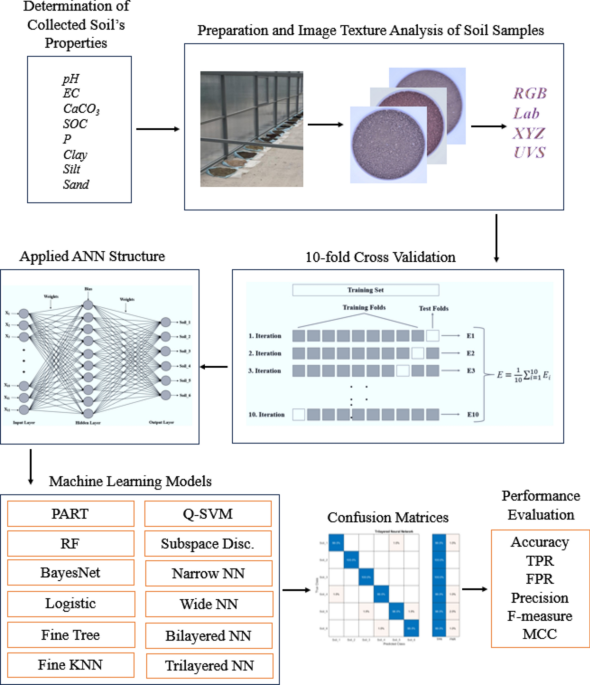Study Reveals Key Soil Properties and Advances in Classification Techniques
A recent study conducted on various soil samples has highlighted important properties and examined innovative machine learning algorithms for effective soil classification. Detailed findings are summarized in Table 1. The soil sample classified as Soil_1 exhibited the highest pH level at 8.46 and an electrical conductivity (EC) of 0.827 ds m−1. Soil_5, on the other hand, recorded the highest percentage of calcium carbonate (CaCO3) at 21.120% and a significant organic matter content of 5.95%. Notably, Soil_1 and Soil_3 showcased the highest phosphorus concentrations at 5.494 and 5.179, respectively, while Soil_5 had the lowest phosphorus concentration at 2.545. The composition of clay, silt, and sand in the samples ranged from 10.71 to 13.94, 18.18 to 28.28, and 59.60 to 67.91, respectively.
Methods of Analysis
The study employed two distinct analytical methodologies. The first utilized a range of machine learning algorithms, including Fine Tree, Quadratic SVM, Fine KNN, and Subspace Discriminant, as well as neural networks like Bilayered, Wide, Narrow, and Trilayered Neural Networks, implemented through MATLAB. The second method leveraged PART, Random Forest, Bayes Net, and Logistic algorithms using WEKA. In total, twelve algorithms were developed and their performance was meticulously compared.
Results and Accuracy
Among the algorithms, the Fine Tree achieved an impressive overall accuracy of 99.7%, with a false negative rate (FNR) of 1% identified in the Soil_1 and Soil_4 samples. Other soil groups obtained a classification accuracy of 100%. Both Quadratic SVM and Fine KNN also achieved an accuracy of 99.7%, with Soil_4 and Soil_6 achieving 99%. The Subspace Discriminant algorithm outperformed all others with an overall accuracy of 99.8%, although Soil_4 recorded a true positive rate (TPR) of only 99%. Neural networks showed a solid performance with the Wide, Narrow, and Bilayered Neural Networks all scoring 99.5%, while the Trilayered Neural Network had a slightly lower accuracy of 99.2%.
Figures 3 and 4 depict confusion matrices for the traditional machine learning and neural network approaches, respectively. The neural network algorithms consistently classified most soil samples with high accuracy, although Soil_4 and Soil_6 showed slightly lower rates.
Other Machine Learning Algorithm Performances
Further analysis of the PART, Random Forest, Bayes Net, and Logistic algorithms revealed that the PART algorithm achieved a remarkable classification accuracy of 99.67%. Notably, Soil_5 and Soil_6 had precision values of 0.990, while the other samples exhibited a precision of 1.000. The highest Matthew’s Correlation Coefficient (MCC) and F-measure were 1.000 for Soil_1, Soil_2, and Soil_3, while Soil_6 recorded the lowest MCC and F-measure values at 0.988 and 0.990, respectively. The overall average accuracy for the Random Forest algorithm was similar, at 99.67%.
Among the assessed algorithms, the Bayes Net achieved the highest average accuracy of 99.83%, demonstrating a robust performance across most soil classifications. The Logistic algorithm, however, returned a lower average accuracy of 99.50%.
Conclusion and Implications
The results indicate that the most successful models were Bayes Net (99.83%), Subspace Discriminant (99.80%), Quadratic SVM (99.7%), Fine KNN (99.7%), and Fine Tree (99.7%). Among neural networks, the Narrow, Wide, and Bilayered configurations were most effective at 99.5%, while the Trilayered model was slightly less successful at 99.2%.
These findings underscore the significance of soil texture properties, which impact fertility and water retention, essential factors for agricultural yield. The research emphasizes the need for accurate soil evaluations to mitigate erosion and enhance agricultural fertility.
The study concludes that effective soil monitoring is crucial for achieving sustainable development. The integration of machine learning and computer vision technologies holds the potential to revolutionize soil texture analysis, making it more accurate and efficient. This advancement not only bolsters soil assessment processes but also enhances the reliability of soil texture estimates, essential for informed agricultural and environmental decision-making. The development of digital soil maps, bolstered by citizen science initiatives, contributes to better local validity and studying soil resources to promote sustainable land management practices.




